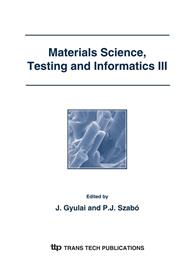p.297
p.303
p.307
p.315
p.321
p.329
p.337
p.345
p.355
Characterization and Comparison of Rapidly Solidified Al Particles Mechanically Milled Nanostructures and their Consolidated Structures Made by High Energy Rate Forming (HERF) Technique
Abstract:
The aim of the present work is to produce new types of solid nanomaterials for different purposes (coatings, fillers, foams, bulk pieces, etc.). Technologies such as RS Al flake production, high energy mechanical milling and high energy rate forming technology (HERF) for compacting are used. The products are analyzed mainly by XRD, SEM and TEM methods. It was shown that the new-type of RS Al “flake” material is suitable not only for pigments but also for powder metallurgical purposes, i.e. Al based nanocomposites. By choosing suitable parameters for mechanical alloying with the Fritsch Planetary mill 4, very fine, alloyed and composited nanostructures can be produced (Al-4.5w%Cu- 10w%Al2O3, Al-15w%Pb) Dynamic compaction (HERF) using explosive techniques seems to offer a good way for the compaction of Al (metal) matrix nanostructured composites.
Info:
Periodical:
Pages:
321-328
Citation:
Online since:
February 2007
Price:
Сopyright:
© 2007 Trans Tech Publications Ltd. All Rights Reserved
Share:
Citation:


